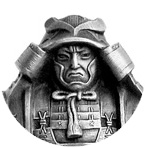The sword
Samurai I: Ascension
-
Everyone who has the right to wear a long sword,
must remember that his sword is considered as his
soul and part with it only when the samurai quits his life.
—Tokugawa Ieyasu
“A weapon makes a man noble,” the ancient saying goes. Warriors have always revered their swords and felt a profound unity to with them. The cult of the sword sprang up with the emergence of the military elite. In fact, the samurai have the longest tradition as a warrior caste and their attitude to the sword plays a central role. “The sword is a warrior’s soul,” Bushi-Do says. The sword has become a synonym for ‘samurai,’ representing intimate matters and his unfailing Spirit.
The sword was the main sacred regalia of the Japanese emperors. In mythology, they received their swords from the Gods, and in Shinto, swords represented their bodies and souls. Legend has it that the emperor’s sword, called Kusanagi, was discovered by Susanoo (god of sea and storms and brother of Amaterasu, goddess of the Sun) in the tail of the eight-headed serpent he had slain. It possessed many mystical qualities, strong magical powers and was identified with lightning. The emperor keeps the sacred sword in the shrine of Asuka Village and uses it twice a year during the purification ritual which is essential in Shinto. It is in fact unknown whether it is truly the sacred sword – the gift from Gods, or a different sword of ancient origin.
Doubts regarding the sword’s origins were fueled by the tragic events during the naval battle between the Taira and Minamoto in Dan-no-ura Bay in 1185 when the child emperor perished. Some scholars think that the sword sank along with the emperor, while others believe the sword remained on board. There are several versions of the precious sword rescue story. Perhaps the most romantic one says an eagle caught the falling sword and brought it to his nest. Later on, it was found and returned to the imperial family.
Japan has many sword legends. They were considered animate objects with spirits and souls. A warrior’s defeat was always linked to the loss of the sword’s spirit and mystical power. Swords were given names which future generations retained. Certain swords even committed supernatural acts. In one legend, famous samurai Taira Tadamori’s sword left the scabbard by itself and killed the snake he had overlooked. In another tale, a sword refused to kill his owner and when he angrily threw it aside, it cut a stone in half.

Like Sakura Petals Samurai art by Tatiana Berg | Purchase print or painting | All ArtworkEach sword inherited its owner’s soul. It could either be a curse if it did not find a ‘common language’ with its owner or could imbue him with supernatural powers. Every famous sword had a distinct character. For instance, prominent swordsmith Muramasa’s weapons were believed to contain strong, savage spirits whose insatiable lust for blood impelled their warriors to commit murder or suicide. They were considered so dangerous and cursed that the shogun banned them during times of peace.
The samurai believed their swords protected them against evil spirits. It was tradition to put swords next to children’s beds, as well as injured or dead samurai. Their swords accompanied them throughout their lives and were kept in a place of honor in their homes. At night they were placed on a special rack next to their beds for easy access, if necessary... Read further in Samurai: AscensionBack to the Blog
This is an abstract from the chapter "The Sword" from Samurai I: Ascension

